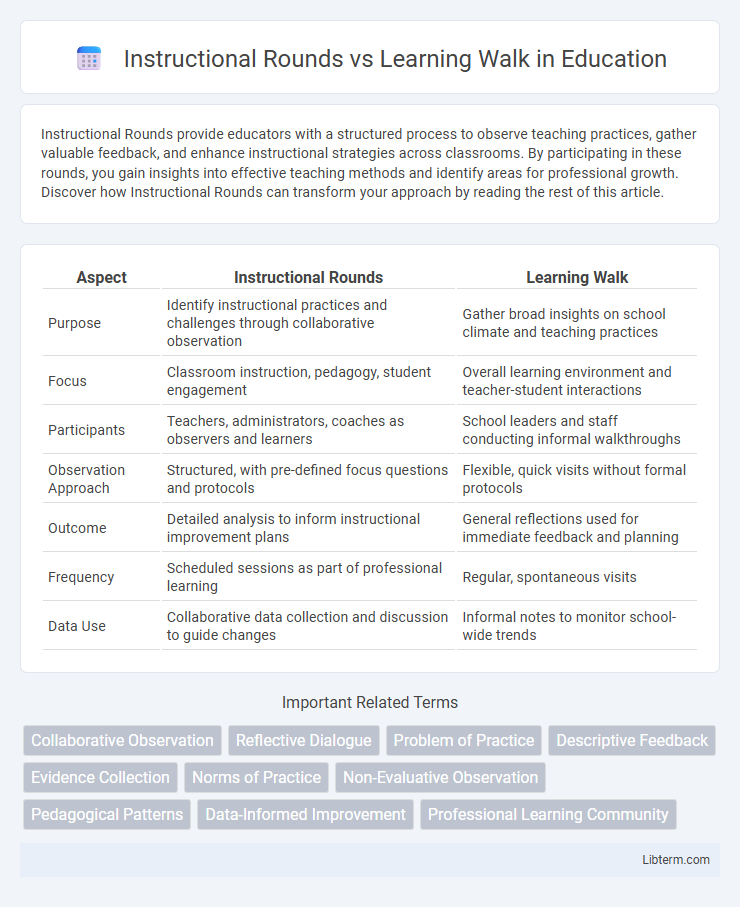Instructional Rounds provide educators with a structured process to observe teaching practices, gather valuable feedback, and enhance instructional strategies across classrooms. By participating in these rounds, you gain insights into effective teaching methods and identify areas for professional growth. Discover how Instructional Rounds can transform your approach by reading the rest of this article.
Table of Comparison
| Aspect | Instructional Rounds | Learning Walk |
|---|---|---|
| Purpose | Identify instructional practices and challenges through collaborative observation | Gather broad insights on school climate and teaching practices |
| Focus | Classroom instruction, pedagogy, student engagement | Overall learning environment and teacher-student interactions |
| Participants | Teachers, administrators, coaches as observers and learners | School leaders and staff conducting informal walkthroughs |
| Observation Approach | Structured, with pre-defined focus questions and protocols | Flexible, quick visits without formal protocols |
| Outcome | Detailed analysis to inform instructional improvement plans | General reflections used for immediate feedback and planning |
| Frequency | Scheduled sessions as part of professional learning | Regular, spontaneous visits |
| Data Use | Collaborative data collection and discussion to guide changes | Informal notes to monitor school-wide trends |
Understanding Instructional Rounds
Instructional Rounds emphasize collaborative observation and analysis of teaching practices to improve student learning outcomes by identifying effective strategies and areas for growth. This process involves educators systematically observing classrooms, collecting qualitative data on instructional methods, and engaging in reflective discussions to build collective capacity. Unlike Learning Walks, which often focus on general school culture and environment, Instructional Rounds target specific pedagogical practices to enhance instructional quality.
What Are Learning Walks?
Learning walks are structured school visits where educators observe classroom instruction to gather data on teaching practices and student engagement, aiming to promote continuous improvement. Unlike instructional rounds, which are more formal and collaborative, learning walks provide flexible, informal opportunities for teachers and leaders to reflect on instructional effectiveness. These walks emphasize real-time feedback and shared learning to enhance instructional quality and student outcomes.
Key Differences Between Instructional Rounds and Learning Walks
Instructional Rounds emphasize collaborative teacher observation and data-driven analysis to improve instructional practices through structured dialogue among educators. Learning Walks focus on gathering qualitative insights by administrators or instructional leaders to inform leadership decisions and support classroom environments. Key differences include the participatory nature of Instructional Rounds versus the observational approach of Learning Walks, and their distinct objectives--professional development compared to leadership-informed improvements.
Purpose and Goals of Instructional Rounds
Instructional Rounds focus on collaborative observation and analysis of teaching practices to improve instructional quality and student learning outcomes, emphasizing identifying patterns and actionable strategies within classrooms. Their purpose is to build collective responsibility among educators by fostering professional dialogue around evidence-based practices and student engagement. Unlike Learning Walks, which are often shorter and more informal, Instructional Rounds aim for deeper inquiry into teaching and learning processes to drive systemic instructional improvement.
Objectives of Learning Walks
Learning Walks aim to gather real-time observational data on teaching practices and student engagement to inform continuous instructional improvement. They focus on identifying effective strategies, understanding classroom dynamics, and promoting collaborative reflection among educators. The objective is to create a culture of ongoing professional development by providing actionable insights that enhance student learning outcomes.
Process and Structure of Instructional Rounds
Instructional Rounds involve a structured process where educators collaboratively observe classroom teaching, collect evidence, and analyze instructional practices to improve student learning outcomes. The process follows a cyclical pattern of preparation, observation, discussion, and reflection, emphasizing specific instructional problems of practice within a defined framework. Unlike Learning Walks, Instructional Rounds prioritize data-driven dialogue and systematic problem-solving to identify effective strategies and areas needing support.
Steps Involved in Learning Walks
Learning Walks involve a structured process where educators observe classroom instruction to gather data on teaching practices and student engagement, followed by collaborative discussions to identify patterns and areas for improvement. The steps typically include pre-walk planning to define observation focus, conducting brief and non-evaluative classroom visits, and post-walk reflection sessions to analyze findings and develop actionable strategies. This method supports continuous professional development by fostering a culture of shared learning and reflective practice among teachers.
Impact on Teacher Professional Development
Instructional Rounds provide a structured, collaborative approach for educators to observe and analyze teaching practices, leading to targeted feedback that enhances instructional skills and promotes shared professional growth. Learning Walks foster informal peer observations emphasizing reflective dialogue, which encourages continuous self-improvement and adaptation of teaching strategies. Both methods significantly contribute to teacher professional development by promoting evidence-based practices and fostering a culture of collective responsibility for student learning outcomes.
Evaluating Outcomes: Rounds vs. Walks
Instructional Rounds systematically evaluate teaching practices by focusing on specific instructional goals and collecting data to inform school-wide improvements, while Learning Walks provide a broader observational approach to capture general classroom engagement and instructional strategies. Instructional Rounds prioritize analyzing patterns in student work and teacher interactions to measure progress toward defined outcomes. Learning Walks emphasize immediate feedback and reflective dialogue, allowing for quick adjustments but less emphasis on longitudinal data tracking.
Choosing the Right Approach for Your School
Instructional Rounds emphasize collaborative analysis of teaching practices through structured observations and feedback, ideal for schools seeking in-depth instructional improvement. Learning Walks provide informal walkthroughs focused on classroom environment and student engagement, suitable for quick assessments and fostering a culture of continuous observation. Selecting the right approach depends on your school's goals, staff readiness, and the desired depth of instructional insight.
Instructional Rounds Infographic

 libterm.com
libterm.com